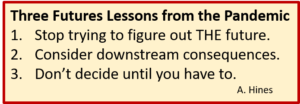I’ve gotten a lot of “what do you think” questions. I’ve done my best to maintain good futu res thinking and avoid getting drawn into the many heated battles over what should we do (mostly succeeding). Here’s a reflection on three futures lessons I wish had been learned.
res thinking and avoid getting drawn into the many heated battles over what should we do (mostly succeeding). Here’s a reflection on three futures lessons I wish had been learned.
- Stop trying to figure out THE future.
A fundamental premise of futures thinking is the value of considering alternative futures. The good news is that there have been lots of good and useful scenarios published for thinking through what lies ahead post-pandemic. But this thinking has largely been drowned out by arguments by those who believe they know what is going to happen and what should be done about it (newly-minted epidemiologists are in full bloom, it seems). Just a few minutes with the established media and social media makes this case – a sometimes vicious jungle, best approached carefully to maintain one’s sanity. My sense of the pandemic landscape is that it is still characterized by huge uncertainty. Nobody really knows! Nobody! In a context of high uncertainty, alternative futures thinking, monitoring the unfolding future for indicators, and embracing a flexible, agile stance with a range of potential options is the most sensible approach. Alas, this is much less sexy than stridently shouting down all the “idiots” who don’t agree with you.
- Consider downstream consequences (second- and third-order impacts).
Futurists routinely use the Futures Wheel and Implications Wheel and other tools to consider the implications or downstream effects of different courses of action. Unfortunately, most decision-making has been primarily focused on the immediate impacts, with little thought to secondary or tertiary ones. To protect public health, a first order response was to lockdown. And the thinking typically stopped there. The obvious second-order impact was a likely economic downturn and loss of jobs. And when you have people locked down for a couple of months, with an economic downturn and job loss, an obvious third order impact was the potential for social unrest. And here we are. But most thinking never got beyond locking down for public health.
- Don’t decide until you have to.
This is less of a fundamental principle of futures thinking than the first two, but a favorite of mine. My futurist friend and mentor Peter Bishop used to joke about how the longest line at futurist meetings would be “late registration.” Some of that might have been poor planning, but I also think futurists recognize that maintaining flexibility and options and not committing until necessary is actually a pretty sound decision-making strategy. Maybe a more attractive option would come up, so keep your options open. It seems that so much of the pandemic decision-making was based on peer pressure, one-upmanship, and even shaming (see my post the mean green meme). A typically media savvy leader implements a strong (and sometimes drastic) response in support of “saving lives” and is applauded as decisive. The media then creates pressure on the next leader to follow suit (well, New York did xyz, so…..). And if they didn’t follow suit, they are called out for risking lives. Cancelling events several months ahead to appear “strong” wins media points, but may turn out to be a bad idea as we learn more (or it may turn out to be “correct,” but what was the hurry). Taking one’s time, considering the available information, and weighing the options carefully would get one labelled as weak or indecisive. But, in most cases, this is the sensible approach.
In sum, a mixed bag. Mostly disappointing, some progress, and still lots of work to do. – Andy Hines.

Leave a Reply